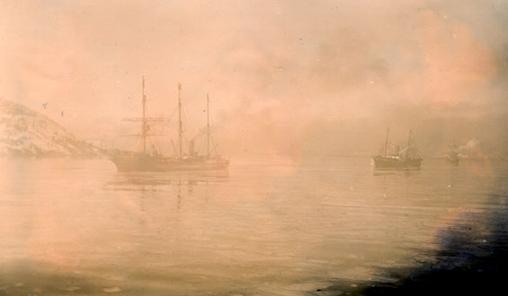


|
Branch Come Home Year August 9-19, 2007 |

|
"S.S. Labrador Shipwrecked In Branch" Submitted By: John Roche
Submitted by: John Roche
|
|
Everyone from Branch has heard of the Labrador, some of us played on the old boiler in the Landwash that probably came off the Labrador or know somebody with something that “came off the Labrador”. This is a short history of the SS Labrador and the story of her last voyage, as told by Capt. Daniel Martin who was in command the day she was shipwrecked in Branch. The story of his battle with the elements and fate is indeed a thrilling and harrowing one and almost defies belief.
The SS Labrador with its three masts was the strongest of the wooden ships in the sealing fishery. The crew at times comprised of 142 men. She was 436 tons gross and 256 net, 139 ft long, 29 ft broad and 17 ft deep. It was built for the Hudson Bay Company in 1891 by Watson of Sunderland England. Capt. George Hann was her first commander and remained with her until 1909. On March 27, 1896 under Captain Hann, she was responsible for saving the crew of The Windsor Lake sixty miles off Cape Freels. From 1891 to 1909, the SS Labrador operated as an Arctic whaler. In 1909 James Baird Ltd. of St. John’s purchased her for the seal fishery for $10,600. Capt. B. Barbour took her over, being in command for the next spring. In 1910 she passed to Capt. Daniel Martin. On March 3, 1913 at 2 PM during a snowstorm she reached Branch and was brought to a standstill on the rocks, which extend from the shore.
The following is excerpted from a letter which Capt. Martin had ready to throw overboard, fearing his ship would founder: “March 3, SS Labrador leaking badly: sprung a leak about 12 to-day; a bad storm on, heavy sea. I am running the vessel before it hoping to get to land. Men are drawing out of the stoke hole. The fire is not out, but men are working hard to keep her free. If any person picks this up send it to Mrs. D. Martin Codroy, Nfld. I leave a wife and dear babe.” D. Martin Hurriedly scribbled in lead pencil, inserted between two leaves of a catechism and placed in a bottle to be thrown overboard. The foregoing was the last “will and testament” of Captain Daniel Martin of the SS Labrador, but for the merciful Providence.
The SS Labrador left St. John’s at 4:30 p.m. Saturday evening March 1st for Channel (Port aux Basques) from which port she was to clear for the Gulf seal fishery. She passed Cape Race on Sunday, the weather was thick and cloudy with a heavy gale from the southeast and then it began to rain. En route that Sunday the steamer was to stop at Trepassey where twenty men would sign on, but there was too much ice so she continued on. During the day she steamed through considerable slob ice. At midnight, the wind veered from southwest to northwest. It continued to increase during the early morn and at daylight it was blowing at hurricane force. At noon she was 25 miles off St. Pierre when the vessel sprang a leak. A tremendous sea was running.
Early in the storm a big wave tore over her bow and all the boats were broken and put out of commission. Capt. Martin headed her for land as their only safety lay in reaching the shore. Another mighty wave struck the large galley, which stood near the foremast, tore it from the deck and threw it against the rail. The stove, funneling, kettles, crockeryware and the cook were scattered around everywhere. A third mountainous comber pounded into the stokehole with such terrible force that it shifted some of the iron plates.
The engineers department worked like Trojans. Coffey and Oke, oilers Lundrigan, who was also third engineer and J. Furlong, firemen T. Evans, J. Richards and J. Aspell did not stop a moment and they were ably assisted by the officers and sealers. The coal in the stoke hold was under water and of no value, so the fuel had to be taken from the hold, passed down through the stoke hold in baskets and put into the furnaces. If the fire failed their steamer would go down carrying all with her, as they had a neither boat and the storm was at its highest. There were seventy men on board and theirs was a race with death. Daylight Tuesday brought no change in conditions. When the land appeared all were grateful. At 2 pm during a snowstorm she reached the cove in Branch and was brought to a standstill on the rocks, which extend from the shore.
With the help of the people of Branch all were rescued.
The crew and sealers were housed in Branch. Three days later on Friday the sealers headed overland for Placentia while Capt. Martin and some of the crew stayed behind. At 6 PM that Friday the sealers reached Patrick’s Cove and remained there until 7 am Saturday when they continued on to Placentia and then on to St. John’s by train. During interviews with the newspapers, they spoke in the highest terms of the treatment accorded them by the people at Branch.
There was a lot of slob ice in the cove, which helped keep the ship semi-submerged. The ice conditions were holding the ship tight to the land. She remained upright in the water which was level with her decks. Many residents of Branch as well as the crew were engaged salvaging the cargo and ships stores but reports indicate that only a small quantity of the stores could be salvaged. For a time it was believed that it might be possible to get the Labrador off the beach and refloated in deep water. Capt. Martin however wired Mr. H. Baird that a survey was held on the vessel and she was pronounced a total wreck.
The Labrador remained upright in the cove for at least a month. On April 5, 1913, it was reported that during a strong gale and heavy seas the Labrador broke in two.
A further chapter of the Labrador was written on April 18, 1913. The men of Branch bought the wreck of the SS Labrador and presented the salable parts to the church. The men met in the school and surprised their pastor, Rev. A. Fyme, by handing over the spars, chains and rigging of the SS Labrador to be disposed of, the proceeds to go to the church building fund. The priest thanked the men for their gift, which was a valuable one. He hoped with the proceeds of the gift to put a spire on the tower and begin the interior work of the building. It was believed that the portions of the wreck given for sale were first class material and realized a handsome sum.
Probably the best part of the story is that no lives were lost.
“--This account was drawn from newspaper reports published at the time.”
|

